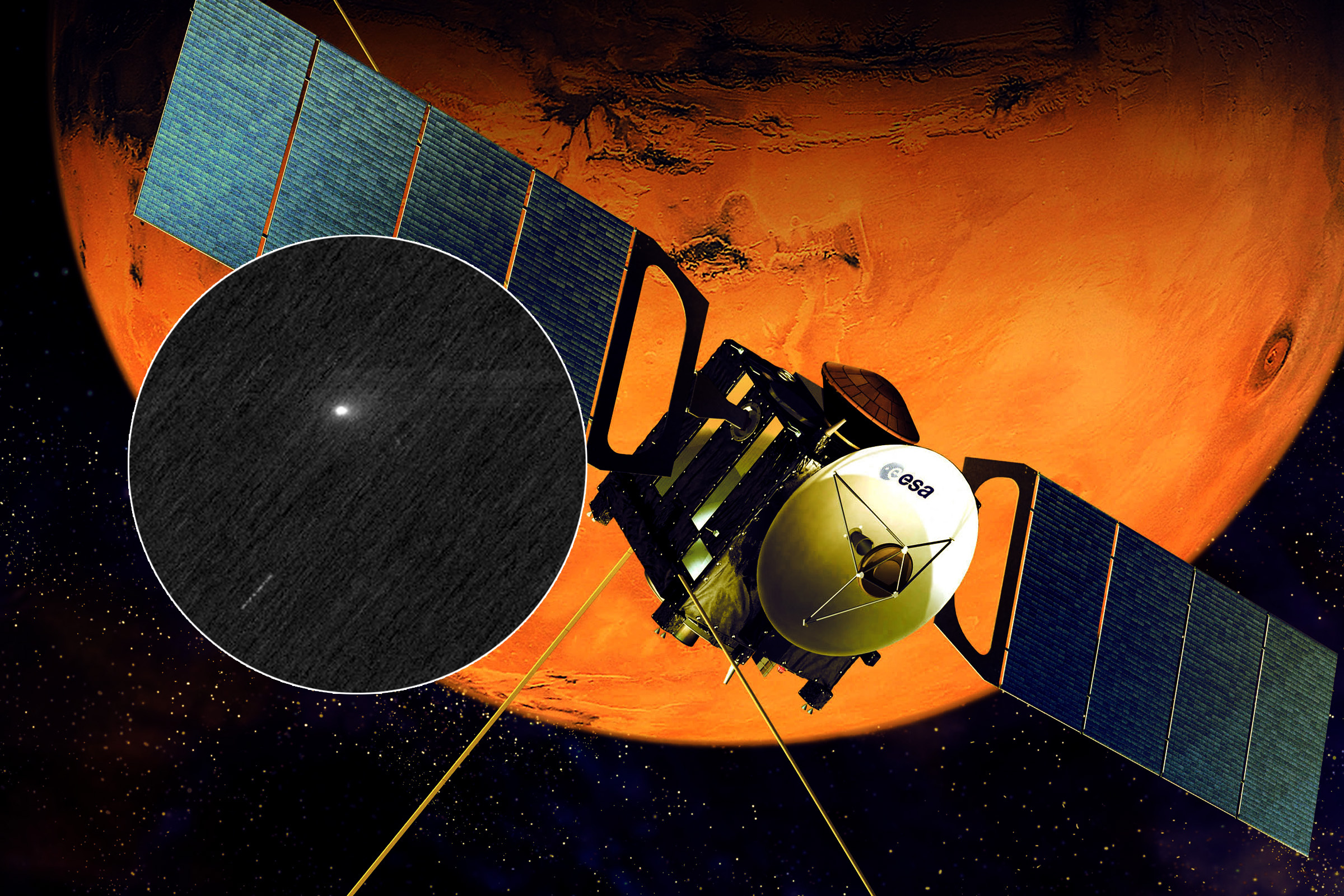
As our solar system’s interstellar visitor hides behind the Sun, humankind’s expeditions to Mars have stepped up to provide an extra set of eyes.
On Tuesday, the European Space Agency announced that two of its spacecraft orbiting the Red Planet had used their cameras to snap photos of the mysterious object, dubbed 3I/ATLAS, as it whizzed past over 18 million miles away from them.
The photos were taken on October 3, when 3I/ATLAS made its closest approach to Mars, using the ExoMars Trace Gas Orbiter (TGO) and the Mars Express spacecraft.
In a series of images captured with the TGO’s Color and Stereo Surface Imaging System (CaSSIS), a glowing dot can clearly be seen inching downward across the black expanse of space. That mobile dot is the coma of the interstellar object, which is widely believed to be a comet.
“Though our Mars orbiters continue to make impressive contributions to Mars science, it’s always extra exciting to see them responding to unexpected situations like this one,” Colin Wilson, the ESA’s Mars Express and ExoMars project scientist, said in a statement. “I look forward to seeing what the data reveals following further analysis.”
Deputizing the Mars spacecraft to try observe the comet was a literal shot in the dark, since both of their cameras are designed for imaging Mars’ well-lit surface, and not tiny specks in the night sky — but it paid off. 3I/ATLAS in the CaSSIS timelapse is as clear as day, showing that its coma — the glowing halo of gas and dust that gives comets their distinct look — is around several thousand miles across.
Comas form as a comet nears the Sun and starts to heat up. This causes the material trapped in its core called a nucleus to either sublimate or evaporate, forcing gas and dust to come pouring out of its shell. These are thousands of times larger than the actual nucleus itself.
“This was a very challenging observation for the instrument,” Nick Thomas, principal investigator of the CaSSIS camera, said in a statement. “The comet is around 10,000 to 100,000 times fainter than our usual target.”
While the coma is easily spotted, the CaSSIS image couldn’t distinguish the nucleus at its center. That’s because, as the ESA explains, imaging the less-than-a-mile-across nucleus “would’ve been as impossible as seeing a mobile phone on the Moon from Earth.”
The Mars Express also turned its gaze towards the comet, but scientists are still examining the images to reveal it. Unlike the TGO’s instrument which was able to take pictures with a five second exposure, the Mars Express camera could only use an exposure time of half a second.
The ESA’s announcement comes just a day after speculation that a fellow Martian explorer, the NASA Perseverance rover, had caught a glimpse of 3I/ATLAS, which appeared as a blurry, cylindrical streak. The idea was propounded by famed Harvard astronomer Avi Loeb, who’s been prolifically writing about the object since it was first spotted (and in which he’s never missed an opportunity to float the possibility that the object is the work of aliens.)
But that may not be the case. David Kipping, an astrophysicist famous for his work on exoplanets and who runs the YouTube channel Cool Worlds, was skeptical that the rover’s puny camera would’ve been able to spot the comet.
On his social media, Kipping argued that the likelier explanation for what was actually depicted in the image was Phobos, the innermost of Mars’ two moons. Astrophotographer Simeon Schmauß agreed that it was almost certainly Phobos, and added that the Martian moon only appeared cylindrical because of the image’s long exposure.
That likely false alarm underscores the excitement around 3I/ATLAS, which is only the third interstellar object known to visit our solar system in history. This one is unbelievably ancient, too: astronomers estimate that it may be more than seven billion years old, making it more than 3 billion years older than the Sun. Over those untold eons, it traveled from a star system somewhere near the center of the Milky Way, where it was likely ejected by a gravitational disturbance like a passing star.
Examining 3I/ATLAS has provided us with unprecedented insights into foreign star systems. Its chemistry is wildly different from the comets of our solar system, including having an unusually high ratio of carbon dioxide to water. Dazzling the eyes, it also began changing color before it disappeared behind the Sun.
Unpacking all the data gathered on the comet will take years. But in the meantime, the ESA says it’ll try take even more observations with 3I/ATLAS using its Jupiter Icy Moons Explorer (Juice). These photos are expected to be extra juicy — pun intended — because they’ll be capturing the comet right after it finishes its closest approach to the Sun, when it will be most active.
More on 3I/ATLAS: The Mysterious Object Cruising Through Solar System Is Releasing Strange Metals, Paper Finds


